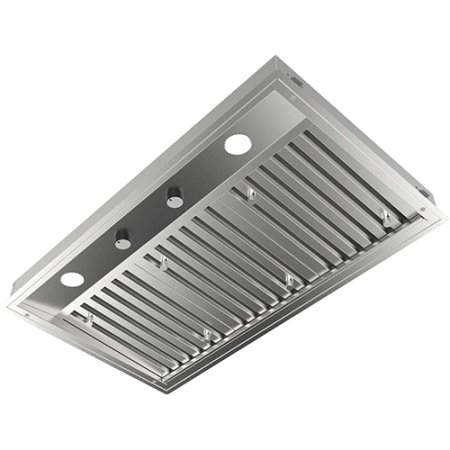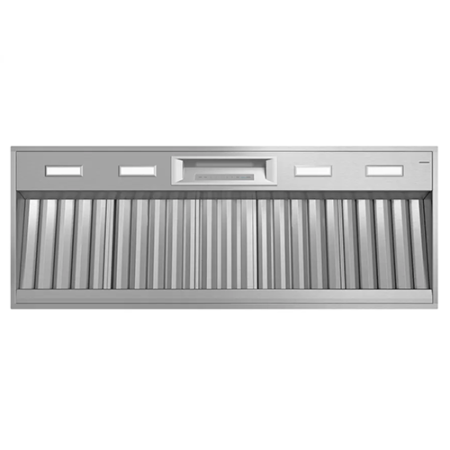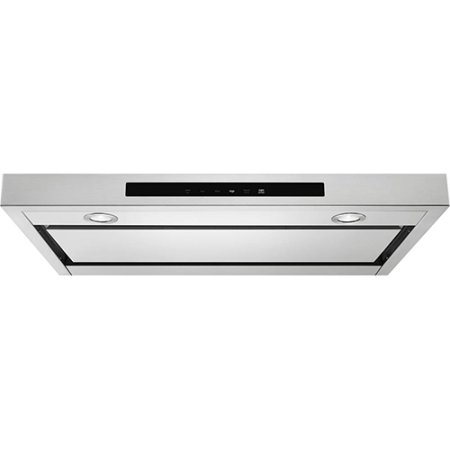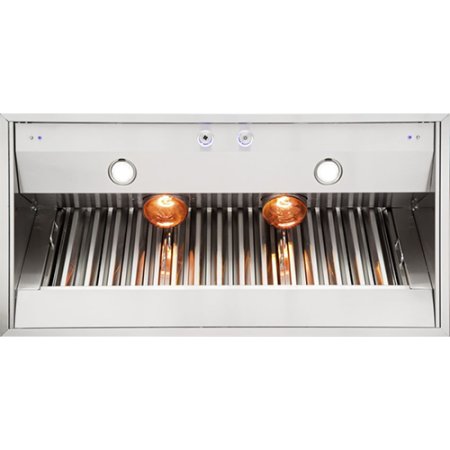We may earn revenue from the products available on this page and participate in affiliate programs.
Stainless steel chimneys; wood-paneled vents; brass-covered, curvy wall mounts—range hoods are often treated as an architectural focal point. But sometimes when space is tight or ornamentation isn’t really your thing, something smaller is better.
Many of the streamlined, clean spaces by New York–based Shapeless Studio feature an under-cabinet range hood. “Ventilation is great, but it doesn’t need to be the crown jewel of the kitchen,” points out Jess Hinshaw, one of the firm’s founders. She and partner Andrea Fisk—who are no strangers to navigating tiny kitchens—often opt to build an insert into upper cabinetry (hello, extra storage) or pair a hood with a custom enclosure to disguise the material, hiding it behind shiplap or beneath a floating shelf. The best under-cabinet range hood, in other words, is designed to disappear.
In fact, Washington-based designer Lisa Staton agrees that choosing this hood type is more about aesthetics than functionality (though including cooking ventilation is always a practical choice). “We love them because it makes kitchens feel less kitchen-y” she shares, explaining that this variation of hood can often soften the space, making it seem not so industrial or utilitarian. But no matter if you’re on the hunt for compact or minimal vent options, we asked six designers for the best under-cabinet range hoods they love to use.
Our Favorites
- Best for easy upkeep: Fabers Inca Pro Plus
- Best for cooking enthusiasts: Miele DAR1130 Cabinet Insert Hood
- Best for minimalist designs: Thermador Professional Custom Insert Hood
- Best for small spaces: Prestige Power Pack Compact Hood Filter Insert
- Best for bargain hunters: KitchenAid Convertible Range Hood
- Best for luxurious living: Viking 5 Series Built-in Custom Ventilator
Best for Easy Upkeep: Fabers Inca Pro Plus
Fan speeds: Variable | Width: 36 inches | Built-in light: Yes
What we like:
- 5-watt LED bulb
- Dishwasher-safe stainless steel filters
Worth noting:
- Blower sold separately
Why we chose it: If you’re trying to avoid a full-blown construction project from taking place in your kitchen, this low-maintenance vent is for you.
“When determining which type of concealed vent hood will best suit our clients’ needs, we first consider the blower type,” offers designer Joshua Smith. “If they’re wanting a simpler installation process, then a model with an internal blower will be our go-to.” His favorite? Faber’s Inc Pro Plus. “These models simply filter the cooking exhaust and then recirculate it inside, and are usually the more price-conscious option,” he adds (in fact, the 36-inch model is available for $849). They feature stainless steel filters (which prevent particles and oils from cooking going back into your kitchen) that are removable and fine to stick in the dishwasher. Affordable and simple to clean? Sign us up.
Best for Cooking Enthusiasts: Miele DAR1130 Cabinet Insert Hood
Fan speeds: Five | Width: 36 inches | Built-in light: Yes
What we like:
- Temperature sensor
- Dishwasher-safe stainless steel filters
Worth noting:
- Can’t be purchased online
Why we chose it: When it comes to cool, cooking-related technology, Miele is a standout brand.
Both Kim Armstrong and Sabrina Albanese are fans of Miele products for offering a wide range of sizes, which is great for when the two find themselves taking on projects as small as condo-size kitchens or as large as an estate home. But what Albanese is especially partial to is the brand’s intuitive technology, perfect for regular cooks. “The Miele hood fan will automatically turn on if it senses there is too much heat, and includes an app that allows you to control the hood fan when you’re not there,” she shares, though she does add it’s always a good idea to run your vent for a few minutes prior to cooking anything that’s bound to swath your room in smells (fish fry, anyone?). With a temperature sensor, the Miele ensures both worry-free cooking and avoids unnecessary energy use.
Best for Minimalist Designs: Thermador Professional Custom Insert Hood
Fan speeds: Four | Width: 40 inches | Built-in light: Yes
What we like:
- Wall or island applications available
- Digital, illuminated buttons
Worth noting:
- Remote control sold separately
Why we chose it: The latest custom inserts from Thermador include remote control compatibility via Wi-Fi to operate external fans.
Thermador is the brand Staton returns to time and time again for kitchens that want to conceal a vent with cabinets or tile. She loves it for its great price, dependability, and overall quiet fan system. In a Seattle home she worked on, going with an under-cabinet range hood allowed the mid-century–inflected kitchen’s millwork to shine. Aside from its luxurious looks, Thermador is also beloved for its reliable performance—an external blower is a must for at-home chefs—and the latest models feature custom settings that can be controlled with a downloadable app, which also includes a feature to remind you when it’s time to clean the dishwasher-safe removable filters.
Best for Small Spaces: Prestige Power Pack Compact Hood Filter Insert
Fan speeds: Variable | Width: 30 inches | Built-in light: Yes
What we like:
- Made in the U.S.
- Dimmable lights
- Free shipping
Worth noting:
- 30-day return policy via Wayfair
- Installation instructions don’t include illustrations
Why we chose it: As far as Hinshaw and Fisk of Shapeless Studio know, this is the smallest unit on the market for internal fans.
More often than not, under-cabinet range hoods feature a larger depth than most cabinetry, meaning the stainless steel can poke out just a touch. If you’re determined to completely hide it, this 11.5-inch option features the same depth as most upper cabinetry, which is why it’s one of Hinshaw’s favorites. With a full 400 or 600 cubic feet per minute (CFM), its 30-inch width doesn’t make it less compatible with high output ranges or cooktops. It also comes with an optional wall switch kit (for $80 extra, though one reviewer notes the expense is worth it) to easily adjust fan speeds and light output from halogen bulbs, especially if you have this installed pretty high up.
Best for Bargain Hunters: KitchenAid Convertible Range Hood
Fan speeds: Three | Width: 42 inches | Built-in light: Yes
What we like:
- Affordable
- Touch-sensitive controls
Worth noting:
- Back-ordered
Why we chose it: A cost-effective, no-frills, low-profile hood that’s a breeze to operate.
KitchenAid is another brand that Armstrong trusts, and for just a little more than $800, this vent hood is the most affordable on the list, while still earning major points for getting the job done (read: keeping smoke and scents from lingering in your kitchen). As streamlined in its design as it is in operation, the 400 CFM vent can switch between three fan speeds and a standard lighting system with dual LED lights. It can fit a standard 6-inch-round duct, which means it’s compatible with both vent and nonvent systems. If you want an upgrade, Armstrong also suggests this four-speed option.
Best for Luxurious Living: Viking 5 Series Built-in Custom Ventilator
Fan speeds: Four | Width: 42 inches | Built-in light: Yes
What we like:
- Optional heat lamp to keep food warm
- Three-year warranty
- Backlit knobs control light and fan speeds (that retract when not in use)
Worth noting:
- Works best when combined with Viking ranges
- 10-inch duct
Why we chose it: Heavy-duty, seamless design that’s extra-quiet.
If you can use a ducted unit, Hinshaw swears by Viking’s Custom Ventilators. “This unit can use a remote fan, which is located at the end of the duct run—outdoors—which means you can barely hear it,” she says. And Viking’s updated 5 Series is as good as it gets (the original design that made Viking a household name). Although Shapeless Studio taps the brand for residential projects, Viking’s filters can hold their own in commercial-rated kitchens, which translates to less maintenance at home (less cleaning, less replacing). The studio also touts that Viking has the quietest hood-and-blower combination in the industry. But for supreme silence, you can’t go wrong with adding on an in-line duct silencer to your purchase.
Runners-up
- When it comes to cooking hoods, Belgium-based designer Dries Otten always recommends Novy. “Depending on the size of the cooking fire and the position of the hood, we suggest the Novy Pure Line or the Novy Mini Pure Line,” shares Otten. “The nice thing about the Pure line is that it can be installed up to [5 feet] above the workbench (for example, in the ceiling), which makes it possible to create a more architectural composition. It gives us designers a bit more freedom.” (Spoiler alert: may only be available in Europe!)
- Hinshaw is also a fan of Bertazzoni. “It is a bit deeper than a typical upper cabinet, which is something to consider during design,” she says, which means the steel might still be visible after install. “Deeper models are typically better for extracting odors, since they can capture more of the cooktop surface.”
- “Zephyr makes great quality range hoods with a nice streamlined design and is well-priced,” offers Seyie Putsure. “It also has a discreet logo which is appealing when mixing it with appliances from other manufacturers.”
How We Chose These Products
We tapped six different designers who have worked in both small and large kitchens to share the best under-cabinet range hoods. Their favorite brands and products all feature built-in lights and add-ons to quiet noisy fans.
Our Shopping Checklist
Hood Types
According to Shapeless Studio’s Hinshaw and Fisk, there are three main under-cabinet range hood types shoppers should know:
- Ducted is, in their opinion, the best option, because it sends exhaust outside. It’s especially ideal for those who cook often or have a tendency to prepare meat and smoked dishes like blackened fish, they say.
- The biggest defining feature of a recirculating vent is a series of filters that traps particles and oils before returning the filtered air back into the room.
- And last but not least, convertible—which, as its name suggests, can change between a nonvent (with the addition of extra filtration) or a vent with a duct.
“When choosing, the first thing we consider is whether it’s possible to even install a ducted unit,” Fisk points out. “In freestanding homes this is often fairly easy, but in apartments—especially older buildings—we don’t always have this option. We end up using a convertible insert unit, which we create a custom shroud for. Sometimes we install a very short duct above the convertible unit so we can locate the return air grille in a less visible location.”
Size
When it comes to deciding on dimensions, it’s important to choose a range hood that’s either the same width of your cooktop or just ever so slightly larger. Most options are anywhere from 30 to 60 inches in width. For depth, Fisk suggests going with one that’s as deep as possible (without compromising design, of course). Smith adds that he also takes the cabinetry into consideration, as that’s ultimately the beauty of an under-cabinet range hood. “They’re tucked away out of sight and concealed within the same material as the cabinetry, whether that be wood or lacquered,” he notes, adding that means you’ll want to go with a size that looks cohesive and clean.
Maintenance
Depending on how often you cook, experts will tell you to clean your filters every couple of months, though some brands more specifically suggest every 40 hours spent working on top of your range. And nearly all the options designers recommend are dishwasher-safe, meaning you can remove the filters—typically made from stainless steel or mesh aluminum. Just give them a wipe to get rid of any excess grease before popping them in the wash.
Ask Domino
Q: What does CFM stand for anyway (and why is it important)?
CFM stands for cubic feet per minute, a measurement of how much airflow moves through the range hood. In fact, for every 10,000 BTUs (aka heat) of your stovetop, Staton recommends at least 100 CFM. “You need to select a fan with the proper CFM for your range or else you can short the wires in the hood by overheating, damage the backsplash, or discolor window coverings or decorative light fixtures that may be flanking the hood,” stresses Albanese. “Gas cooktops usually require more CFMs, as they give off more heat than an electric or induction cooktop.” A general rule of thumb, according to Shapeless Studio, is that a 36-inch range requires anywhere from 350 to 700 CFM, whereas something larger, like a 48-inch range, needs 400 to 800 CFM.
Q: A noisy range hood drives me crazy—what should I look out for if I want something quiet?
If noise is a deal breaker, you might want to look into whether or not your range features external or internal blowers (aka the exhaust fan). “Vent hoods with external blowers, while quieter, are a more expensive option because they require the installation of ductwork to reroute cooking exhaust outside,” explains Smith, who opts for a model with the lowest decibel rating. That way, he says, the fan sound won’t compromise the ambience of the space. Otherwise, Albanese adds you can look for noise-dampening features. If you’re going with a larger range, often a high-powered fan is required, which is unfortunately going to be loud. Her advice is to add silencers to reduce motor noise.
Q: Can I install an under-cabinet range hood on my own?
This all depends on how comfortable you are with power tools and electric wiring (for us, it would be a pass). Overall, ductless hoods are often far easier to tackle, but if you have a duct setup, you may want to entrust the job to a contractor. While the first option is more of a “secure your wires, plug it in, and you’re ready to go” type of situation, a ducted vent requires an outdoor, external fan to be set up, too.
The Last Word
The best under-cabinet vent hoods are really dependent on the style of kitchen you want (or how much of an at-home chef you consider yourself to be). According to the designers we spoke to, under-cabinet range hoods and built-in inserts are the secret to a contemporary, streamlined kitchen design.







